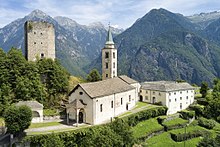Church of Sta. Maria Assunta Calanca
The Catholic parish church of Sta. Maria Assunta stands in a unique panoramic position on a hill outside the village of Santa Maria in Calanca in Calancatal canton of Grisons . Above the church stands the tower of Sta. Maria in Calanca .
history
Although the church was first mentioned in a deed of foundation by Heinrich von Sax in 1219 , one or more previous buildings date back to the 1st millennium. Re-consecrations took place in 1385 and 1416. In 1606 the ship was expanded to its present state, in 1618 the gallery was built. In 1628 Alessandro Gorla painted the choir and added the stucco decorations.
construction
The fact that the nave (27 meters long, 9 meters wide at the front) is 3 meters narrower on the entrance side than on the choir creates a perspective effect. It is covered with a flat wooden coffered ceiling ; the square choir has a groin vault. Walled-up pointed arch windows on the north side prove its Gothic masonry. The Gothic tower with blind niches and pointed arch friezes stands on the north side. The Tuscan porch dates from the 2nd half of the 17th century; the arched stone portal was created in 1606 by Giovanni Andrioli.
Interior
The richly painted Renaissance coffered ceiling with carved rosettes dates from around 1606. The choir ceiling and the brick canopies above the two side altars were stuccoed and painted around 1626 by a Misox master. The putti sitting on the cornices bear the coats of arms of Calanca, the Gray League , Grono and San Vittore GR . The paintings from 1628 are by Alessandro Gorla from Bellinzona. On the long walls of the ship there are remains of a late Gothic wall painting from the end of the 15th century. It shows the Lord's Supper and the Assumption.
The gallery over cross vaults was built in 1618 by Giovanni Andriolo and Antonio Maffero. Agostino Duso created the mural above in 1727, the picture De Julianis von Roveredo 1686 the baptism of Christ below.
Furnishing
In the wooden, richly gilded high altar from 1724 there is a clothed Madonna figure with baby Jesus. A large winged altar by the Upper Swabian artist Ivo Strigel from 1512 was sold to Basel in 1887 and has been in the choir of the Barfüsserkirche in the Historical Museum since 1894 .
In the two-storey southern rosary altar from 1512 from the Christoph Schneller workshop, three figures have probably survived from Strigel's workshop: Sebastian, Maria and Rochus. In the north cross altar hangs a crucifix from the beginning of the 18th century.
There are four more altars on the long walls of the ship. The oldest is the Lazarus altar on the south side from the early Baroque period . The painting from 1646 is by Georg Wilhelm Graesner; it is his first documented work. Next to it is an Antonius altar by G. D. Waser from Roveredo from 1734. On the north wall there is a high baroque Franciscan altar with stucco structure from 1684, next to it a columned retable from 1851.
The pulpit with trumpet-blowing angels and capuchin emblems dates from 1650. The three large-format paintings - Battle of Lepanto, Plague, Granting of the Portiuncula - are also by Graesner. The marble font with a hexagonal, temple-shaped wooden top is from 1610.
Ossuary
To the left of the church entrance is the loggia-like ossuary with cross vaults from the second half of the 17th century.
literature
- Linus Birchler: Sta. Maria in Calanca . Art guide
- Ludmila Seifert, Leza Dosch: Art guide through Graubünden: Scheidegger & Spiess, Zurich 2008, p. 172
- Erwin Poeschel : The Art Monuments of the Canton of Graubünden , Volume 6. Birkhäuser Verlag, Basel 1945.
Web links
Coordinates: 46 ° 15 '43.4 " N , 9 ° 8' 45" E ; CH1903: seven hundred and thirty-one thousand six hundred and eighteen / 124834











